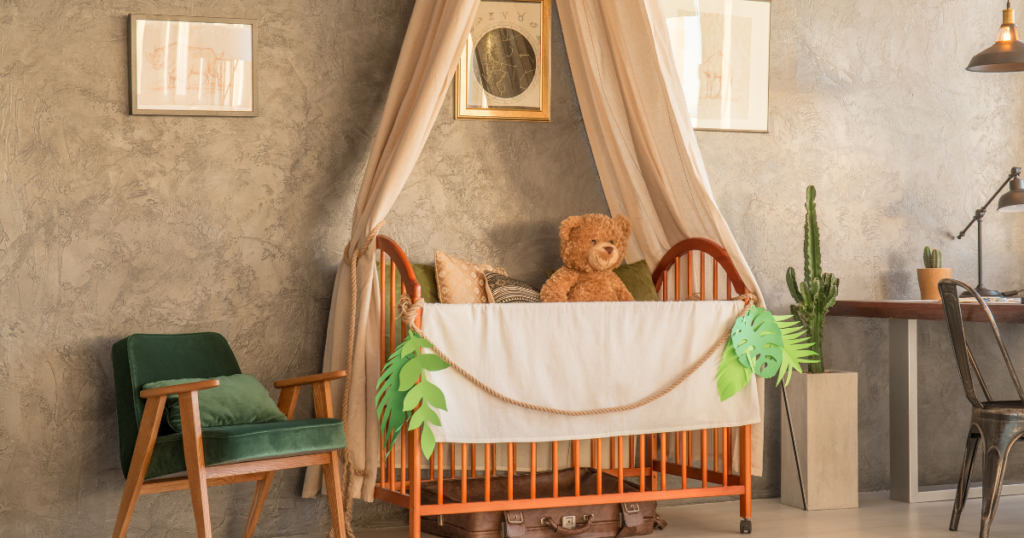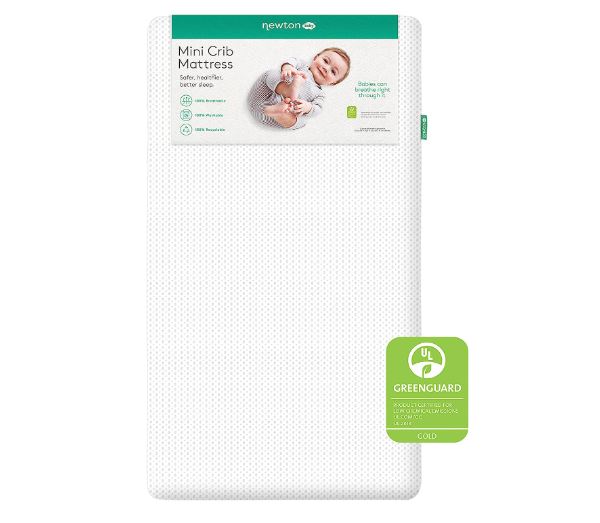For some parents, choosing the perfect crib for your upcoming addition is more than just about safety and functionality—it’s also about style.
The color of a crib can greatly influence the overall aesthetic of your nursery. Two popular choices that have remained timeless in appeal are white and black cribs. Let’s compare the white crib vs. black crib to see if color matters.
In this article, we will look at the advantages and considerations of white cribs and black cribs, as this will help you make an informed choice for your baby’s sanctuary.
Let’s begin by looking at the advantages and practical considerations of a white crib.

The Appeal of a White Crib
Aesthetic Advantages
- Timelessness: White cribs have a classic and timeless appeal. They can easily fit into various nursery designs and remain in style across changing trends.
- Versatility: Due to its neutral nature, a white crib can complement numerous color schemes and themes. Whether you’re going for a bohemian, minimalist, vintage, or modern look, a white crib can seamlessly blend in.
- Brightening Effect: White naturally reflects light, making spaces appear more open and airy. In a nursery, this can help create a calm, serene environment that feels spacious and welcoming.
- Purity and Peace: White is often associated with purity, simplicity, and peace—ideally setting the tone for a restful baby’s room.
Practical Considerations
- Visibility of Stains: One of the significant challenges with white furniture, including cribs, is that stains or discolorations tend to be more visible. This could be from baby food, medicines, or even natural wear over time.
- Maintenance: White cribs may require more frequent cleaning to maintain their pristine appearance. This might mean more regular wipe-downs, especially if there are visible marks or smudges.
- Wear and Tear: Over time, a white crib can show signs of wearing more prominently. This includes potential yellowing, paint chipping, or other age-related marks that might be less evident on darker-colored furniture.
- UV Sensitivity: Prolonged exposure to direct sunlight can lead to the discoloration of white furniture. If the crib is placed near a window, it might be essential to use curtains or blinds during peak sunlight hours.
Summary: While white cribs offer undeniable aesthetic advantages that lend a touch of elegance and serenity to nurseries, they also come with certain practical considerations. Keeping these in mind can help ensure that the crib remains a beautiful and functional piece in the baby’s room for years to come.
Recommended: Beginners guide on how much weight can a crib hold
The Charm of a Black Crib
Although black cribs are less conventional than white ones, they have their unique set of aesthetic benefits and practical considerations. Let’s explore them:
Aesthetic Advantages
- Bold Statement: A black crib makes a striking impression. It’s a distinctive choice that adds a touch of modern sophistication to the nursery.
- Versatility: Black, being a neutral tone, can complement various decors and color schemes. Whether you’re aiming for a monochromatic, contemporary, or even a vintage look, a black crib can fit right in.
- Contrast and Depth: Especially in lighter-colored or pastel-themed nurseries, a black crib can serve as a focal point, adding depth and visual interest to the room.
- Gender Neutrality: For parents looking to design a nursery that steers away from traditionally gendered color palettes, black offers a chic, versatile option.
Practical Considerations
- Dust and Smudges: Black surfaces can make dust, fingerprints, or smudges more noticeable. This could require more frequent wipe-downs to keep the crib looking clean.
- Scratches and Chips: While black may hide certain stains or discolorations better than lighter-colored cribs, scratches or chips in the paint can stand out if the underlying material is lighter.
- Heat Absorption: Black tends to absorb more heat. If the nursery gets a lot of direct sunlight, the crib can become warm to the touch, which might be a consideration in hotter climates or seasons.
- Space Perception: Darker colors can make spaces feel a bit more confined. In smaller nurseries, this might be a consideration for parents who want to maintain an open feel.
White Crib Vs. Black Crib: Which Should I Go For?
If you are contemplating the color of the crib to choose between white crib vs. black crib, the following factors can influence your choice:
Maintenance and Durability
Color aside, regular maintenance ensures longevity. White might require frequent wipe-downs to remove visible marks, while black cribs might need regular dusting. Invest in crib-safe cleaning agents and gentle clothes to keep both looking their best.
The Psychology of Color
Colors influence our mood. White exudes purity, peace, and simplicity. It’s calming and serene. Black, on the other hand, is often associated with elegance, depth, and sophistication. Consider what ambiance you aim for when choosing.
Resale and Future Use
Thinking long-term? White cribs generally have broader appeal due to their classic nature, which might fetch better resale value. However, black cribs, being less common, can stand out in the resale market. Both colors offer versatility for future children or room transformations.
Price Considerations
Both white and black cribs range in price based on brand, design, and material. However, there’s no prominent price difference purely based on color. Always check reviews and ensure your chosen crib meets safety standards.
Related: How long to leave a toddler in the crib if not napping?
FAQs on Cribs Colors
Which crib color is more popular, white or black?
While white cribs have traditionally been more popular due to their classic and versatile appeal, black cribs have gained traction in recent years for their modern and sophisticated look.
Will a white crib stain easily?
White cribs can show stains or discolorations more readily than darker cribs. It's advisable to clean up spills promptly and use crib-safe cleaning agents to maintain its appearance.
Does a black crib get hot if placed near a window?
Black absorbs more heat than lighter colors. If a black crib is placed directly in sunlight, it may become warm to the touch. It's advisable to use curtains or blinds during peak sunlight hours or position the crib away from direct sunlight.
Which crib color is more versatile in terms of nursery decor?
Both white and black colors are versatile in their own right. White cribs tend to be more adaptable to various nursery themes due to their neutral and classic appearance. Black cribs, however, can provide a contrasting focal point, especially in lighter-colored nurseries.
Are there any psychological effects of cribs colors on babies?
Colors can influence mood and atmosphere. White is often linked to feelings of peace, purity, and simplicity, potentially promoting calmness. Black, while not commonly associated with baby rooms, offers sophistication and depth and can create a stylish and contemporary environment.
Are there any notable price differences between white and black cribs?
The color of the crib typically doesn't dictate the price. Instead, factors like brand, material, design, and functionality play a more significant role in determining cost.
Which color shows wear and tear more prominently?
White cribs might show discolorations, yellowing, or chipping paint more over time. Black cribs, on the other hand, can make scratches or chips more noticeable, especially if the underlying material is lighter.
How can I ensure longevity for both crib colors?
Regular maintenance is key. For white cribs, frequent cleaning to remove visible marks is advisable. Black cribs might benefit from regular dusting. Always use gentle, crib-safe cleaning agents.
Are black cribs gender-neutral?
Yes, black cribs are considered gender-neutral and can suit nurseries for both boys and girls.
Can the color of the crib impact the overall perception of room size?
Yes, lighter colors, like white, can make a room appear more spacious and open. In contrast, darker colors, like black, might make smaller rooms feel slightly more confined.
Conclusion
Whether you gravitate towards the pristine charm of a white crib or the bold allure of a black crib, both colors offer fantastic choices for your nursery.
Remember, while aesthetics play a role, the crib’s safety and comfort should always be paramount. Whichever hue you choose, here’s to countless nights of peaceful dreams for your little one.




